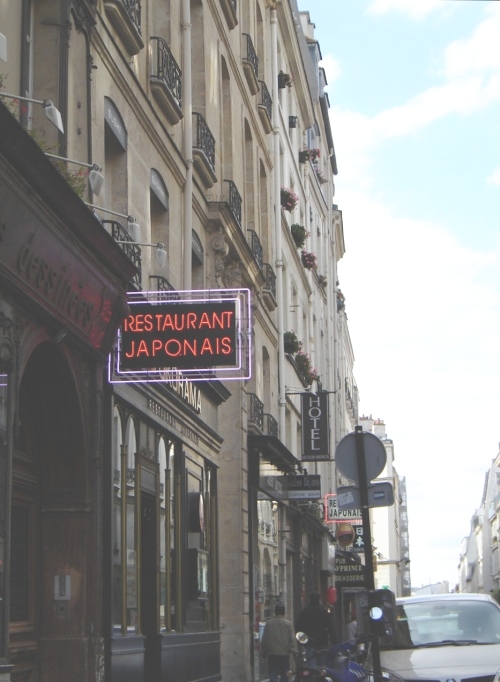
We've got a cute one-bedroom apartment on the fourth floor of a building at 44 Rue Monsieur le Prince — which sounds so much nicer than what I jokingly call it: "Mister the Prince Street". It's in the 5th arrondissement, a little bit east of Jardin du Luxembourg. As you walk to it from the south, this is what you'll see:

As we walked around the apartment we noticed several lights hung at a height of 5 feet, the most inconvenient being directly in front of the sink. The landlord said, "My wife is quite short. You will have many confrontations with this lamp."
He was right — and so far, the lamp has won every time.
There are some other quirky features. For example, there's broadband internet — but you can't use the phone while using the computer! Instead, the phone will take a message... which you can then access via the television.
Despite all this, the place is charming:
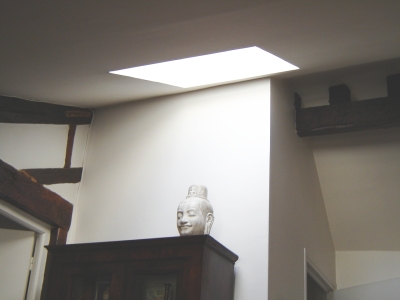
July 2, 2007
It's nice to listen to some new new music in a new place —
it brings back memories later on.
So, I bought a CD of Scarlatti's Stabat Mater at the
classical music store around the corner. This
rich choral work featuring 10 soloists seems to fill our apartment up
to its sloping ceilings. I'd first heard it when visiting my
parents last month — the Gulbenkian Choir performed it at
the Freer. The instrumental accompaniment takes a back seat
on this piece, but it features the theorbo, which I'd never seen before: it's a kind
of overgrown lute. I bought the version by the
Concerto
Italiano.
Today we walked around the Latin Quarter. Here's Lisa in front of the Sorbonne:
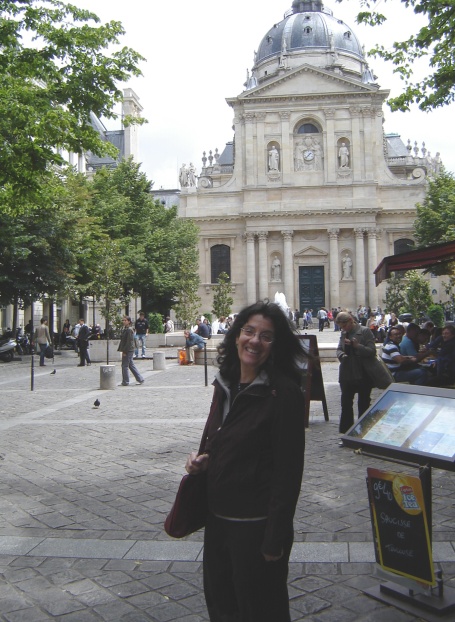
Today is the day that exam scores were posted for all schools in France, from elementary schools to the Sorbonne. Students and some parents lined up, anxiously awaiting the results:
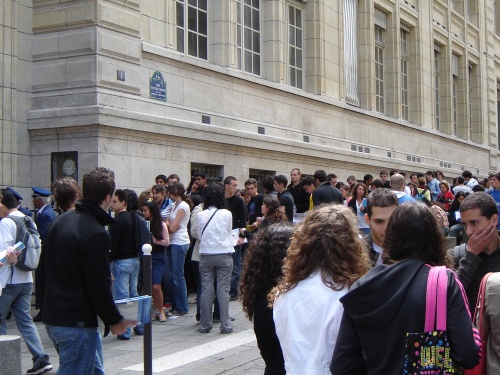
Perhaps it was no coincidence that many cars parked next to the Sorbonne had these fliers placed on their windshields, advertising math tutoring:
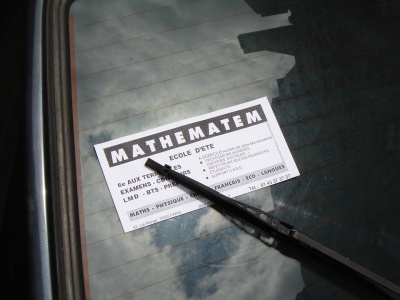
Just for fun, I began
taking photographs of streets named after mathematicians...
or more precisely, of the street signs. Here are two guys
who probably didn't need tutoring to pass their math exams:
Descartes
you surely know.
Paul Painlevé may be most famous as a politician in France, but
mathematicians know him for
his
work on differential equations.
I need to get Rue Monge and Rue Laplace!
A few days ago
Lisa installed wireless internet in our apartment, after I bought
a nice little portable wireless router at fnac for this purpose. It worked nicely, but the
next morning the TV stopped working — all the gadgets in this
joint are connected. After some struggle we managed to get the
phone to work even when the wireless internet was on, but the TV
remained recalcitrant. This evening the landlord came and did
his best, but gave up and said his wife would try later.
In the afternoon Lisa's friend Agnes Chalier visited:
After tea, we all walked over to the
Right Bank:
On the way back home, I took a detour and got a shot of Rue
Monge:
In the evening I finished my talk on Derek Wise's
work, which I'll give on Tuesday at the
AstroParticule et
Cosmologie group at Université Paris 7.
Over at the n-Category Café,
someone pointed out a list of mathematicians with Paris streets
named after them. There are over a hundred!
But, it looks like Rue Malus and Rue Malebranche are the only ones
left in the 5th arrondissement. In the 6th, just Rue Le Verrier!
So, soon I'll have to go further
afield if I want to keep playing this game.
As David Corfield
points out, I can get Rue Newton, Rue Euler, Rue Galilée and Rue Kepler
if I go south of Étoile, a big intersection north of the Seine.
But in case you're wondering: I'm doing lots of other fun stuff,
too!
Now the situation has changed. The threat of global warming is
finally accepted, not just in the rest of the world, but even here
in the US:
It happened in the last two years.
What made the difference? Here's an interesting analysis:
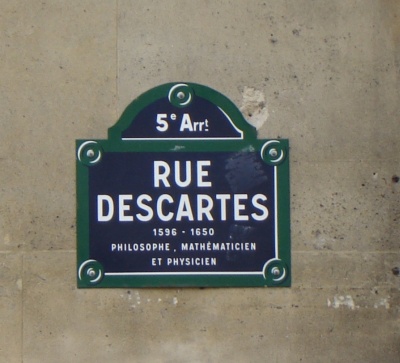
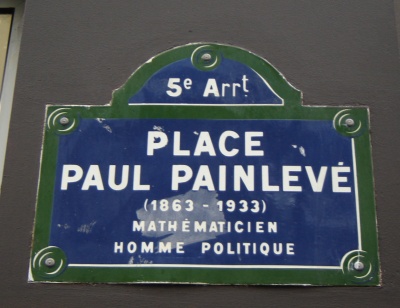
July 6, 2007
I'm developing a routine of meeting Paul-André Melliès
at Café Rostand at 10 in the morning. We've been discussing
category theory. Somewhat to my surprise, he's studied
Jordan–Hölder theorems from the viewpoint of rewrite rules, while
I've been wondering if there's some sort of braided monoidal category
implicit in such theorem — as is evident in Joyal and Street's
work on Hecke algebras, at least in a special case. In his approach
he's bumped into some diagrams resembling the Yang–Baxter equation,
which also shows up in braided monoidal categories.
So, we're trying to understand each other's ideas. It's fun having
no fixed agenda and suddenly stumbling on a puzzle like this.
July 7, 2007
In the morning Lisa and I had our usual croissants and coffee —
there's a bakery downstairs, and each day the aroma of fresh-baked
croissants drifts up, so they're hard to resist.
We went on a long walk to the west end of Saint-Germaine, looking
for a market that sold soap, not finding it.
Then we walked back east along the Seine, then down south a bit —
where I managed to snap a picture of Rue
Lagrange:
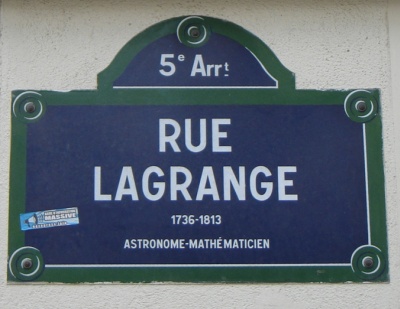
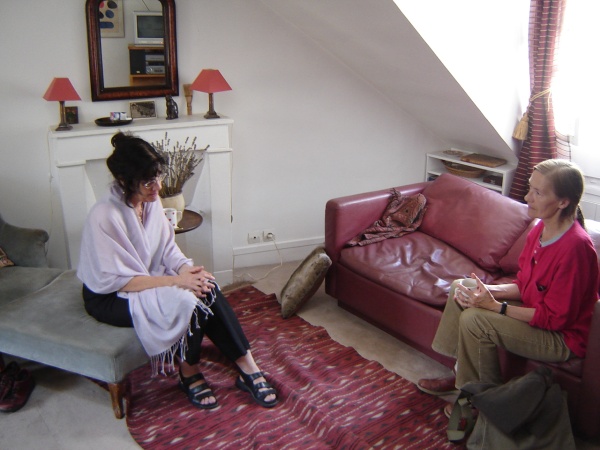
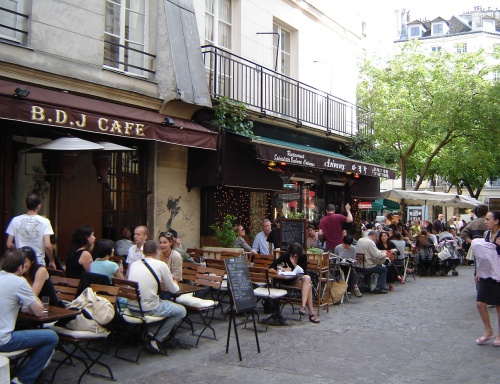
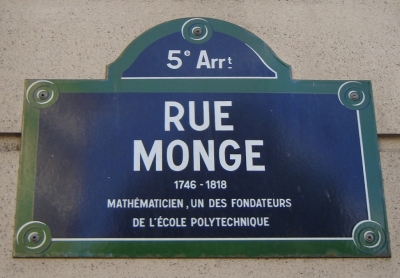
July 8, 2007
I bagged another one — Rue Laplace, just north of the Pantheon:
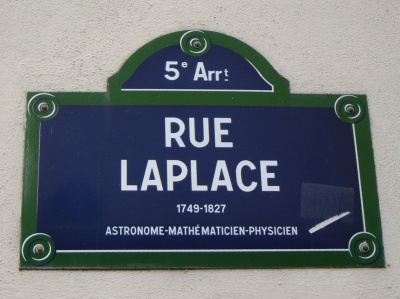
July 9, 2007
When I started talking about climate change in this diary, back in
2004,
I felt a strong need to collect information and publicize it.
The issue wasn't getting much attention in the US media, and
every news item was "balanced" by quotes from
"climate change skeptics" saying there was nothing to worry
about. I was
aghast when I realized how many of these "skeptics"
were funded by Exxon.
Briefly: it's not so much Al Gore as Hurricane Katrina and other
disasters, including the drought
in the Western US, which seems like a harbinger of things to come:

Though no one such disaster can be conclusively linked to global climate change, these are the sort of things that people experience directly — they cut through the chatter:
I don't like to discuss the most alarming climate change scenarios, since they're speculative, and even the less speculative predictions should be scary enough to goad us into action. But, I have questions about the recent work of James Lovelock and James Hansen.
Lovelock has a theory about global warming and algae in the ocean. Some consider it alarmist "climate porn"; other's dont'. I hope it is! Here's the idea in a nutshell, from a website called Ration the Future:
Algae extinction: In 2006, NASA satellites showed that phytoplankton — which absorb carbon dioxide — are finding it harder to live in the more stratified layers of the warmer ocean, which restrict the mixing of vital nutrients. Since 2000, when the sea surface temperatures began to rise more noticeably, the photosynthetic productivity of phytoplankton have decreased in some ocean regions by 30 per cent. James Lovelock points out that as the ocean surface temperature warms to over 12° C, "a stable layer of warm water forms on the surface that stays unmixed with the cooler, nutrient-rich waters below. This purely physical property of ocean water denies nutrients to the life in the warm layer, and soon the upper sunlit ocean water becomes a desert", recognized by the clear azure blue, dead water of 80 per cent of today's ocean surface. In such nutrient-deprived water, ocean life cannot prosper and soon "the surface layer is empty of all but a limited and starving population of algae". Algae, which comprise most of the ocean's plant life, are the world's greatest CO2 sink, pumping down carbon dioxide, as well as contributing to cloud cover by releasing dimethyl sulphide into the atmosphere, gas "connected with the formation of clouds and with climate" (Lovelock 2006: 23), so that warmer seas and less algae will likely reduce cloud formation and further enhance positive feedback. Severe disruption of the algae/DMS relation would signal spiralling and irreversible climate change.If any experts on algae or climate change read this, please send me an email and comment!Algae prosper in waters below 10° C so as the climate warms, the algae population reduces. In computer modelling of climate warming and regulation carried out by James Lovelock and Lee Kump (Lovelock 2006:31-33), it was found that "as the carbon dioxide abundance approached 500 ppm (or a rise of about 3°), regulation began to fail and there was a sudden upward jump in temperature. The cause was the failure of the ocean ecosystem. As the world grew warmer, the algae were denied nutrients by the expanding warms surface of the oceans, until eventually they became extinct. As the area of ocean covered by algae grew smaller, their cooling effect diminished and the temperature surged upwards." The end result was a temperature rise of 8° C above pre-industrial levels, which would result in the planet being habitable only from the latitude of Melbourne south to the south pole, and northern Europe, Asia and Canada to the north pole. Everything in between would be desert and uninhabitable, billions of people would not be able to survive.
My friend the mathematician Bruce Bartlett points out another scary possibility, raised by the famous climate scientist James Hansen and reported by George Monbiot in his usual hair-raising style:
Again, I'd appreciate comments from climate scientists.Planet Earth today: imminent peril
The imminent peril is initiation of dynamical and thermodynamical processes on the West Antarctic and Greenland ice sheets that produce a situation out of humanity's control, such that devastating sea-level rise will inevitably occur. Climate forcing of this century under BAU [business as usual] would dwarf natural forcings of the past million years, indeed it would probably exceed climate forcing of the middle Pliocene, when the planet was not more than 2-3°C warmer and sea level 25±10 m higher (Dowsett et al. 1994). The climate sensitivities we have inferred from palaeoclimate data ensure that a BAU GHG [greenhouse gas] emission scenario would produce global warming of several degrees Celsius this century, with amplification at high latitudes.Such warming would assuredly activate the albedo-flip trigger mechanism over large portions of these ice sheets. In combination with warming of the nearby ocean and atmosphere, the increased surface melt would bring into play multiple positive feedbacks leading to eventual nonlinear ice sheet disintegration, as discussed by Hansen (2005). It is difficult to predict time of collapse in such a nonlinear problem, but we find no evidence of millennial lags between forcing and ice sheet response in palaeoclimate data. An ice sheet response time of centuries seems probable, and we cannot rule out large changes on decadal time-scales once wide-scale surface melt is underway. With GHGs continuing to increase, the planetary energy imbalance provides ample energy to melt ice corresponding to several metres of sea level per century (Hansen et al. 2005b).
With this danger in mind, it is appropriate to closely monitor ice sheet conditions. Area of summer melt on Greenland increased from approximately 450000 km2 in the first few years after satellite observations began in 1979 to more than 600000 km2 in recent years (Steffen et al. 2004). Iceberg discharge from Greenland increased markedly over the past 15 years. Mass loss increased from 4-50 km3 yr-1 in 1993-1998 to 57-105 km3yr-1 in 1999-2004, based on radar altimeters, with probable losses at the higher ends of those ranges (Thomas et al. 2006). Recent analyses of satellite gravity field data yield a net annual loss of 101±16 km3yr-1 during 2003-2005 (Luthcke et al. 2006).
The gravest threat we foresee starts with surface melt on West Antarctica and interaction among positive feedbacks leading to catastrophic ice loss. Warming in West Antarctica in recent decades has been limited by effects of stratospheric ozone depletion (Shindell & Schmidt 2004). However, climate projections (Hansen et al. 2006b) find surface warming in West Antarctica and warming of nearby ocean at depths that may attack buttressing ice shelves. Loss of ice shelves allows more rapid discharge from ice streams, in turn a lowering and warming of the ice sheet surface, and increased surface melt. Rising sea level helps unhinge the ice from pinning points.
West Antarctica seems to be moving into a mode of significant mass loss (Thomas et al. 2004). Gravity data yielded mass loss of approximately 150 km3 yr-1 in 2002-2005 (Velicogna & Wahr 2006). A warming ocean has eroded ice shelves by more than 5 m yr-1 over the past decade (Rignot & Jacobs 2002; Shepherd et al. 2004). Satellite QuickSCAT radiometer observations (Nghiem et al. 2007), initiated in 1999, reveal an increasing area of summer melt on West Antarctica and an increasing melt season over the period of record. Attention has focused on Greenland, but the most recent gravity data indicate comparable mass loss from West Antarctica. We find it implausible that BAU scenarios, with climate forcing and global warming exceeding those of the Pliocene, would permit a West Antarctic ice sheet of present size to survive even for a century.
Our concern that BAU GHG scenarios would cause large sea-level rise this century (Hansen 2005) differs from estimates of IPCC [The International Panel on Climate Change] (2001, 2007), which foresees little or no contribution to twenty-first century sea-level rise from Greenland and Antarctica. However, the IPCC analyses and projections do not well account for the nonlinear physics of wet ice sheet disintegration, ice streams and eroding ice shelves, nor are they consistent with the palaeoclimate evidence we have presented for the absence of discernable lag between ice sheet forcing and sea-level rise.
The best chance for averting ice sheet disintegration seems to be intense simultaneous efforts to reduce both CO2 emissions and non-CO2 climate forcings. As mentioned above, there are multiple benefits from such actions. However, even with such actions, it is probable that the dangerous level of atmospheric GHGs will be passed, at least temporarily. We have presented evidence (Hansen et al. 2006b) that the dangerous level of CO2 can be no more than approximately 450ppm. Our present discussion, including the conclusion that slow feedbacks (ice, vegetation and GHG) can come into play on century time-scales or sooner, makes it probable that the dangerous level is even lower.
Present knowledge does not permit accurate specification of the dangerous level of human-made GHGs. However, it is much lower than has commonly been assumed. If we have not already passed the dangerous level, the energy infrastructure in place ensures that we will pass it within several decades.
We conclude that a feasible strategy for planetary rescue almost surely requires a means of extracting GHGs from the air. Development of CO2 capture at power plants, with below-ground CO2 sequestration, may be a critical element. Injection of the CO2 well beneath the ocean floor assures its stability (House et al. 2006). If the power plant fuel is derived from biomass, such as cellulosic fibres grown without excessive fertilization that produces N2O or other offsetting GHG emissions, it will provide continuing drawdown of atmospheric CO2.
It seems unrealistic to solve the problem just by conservation and switching towards hydropower, wind, solar, and so on — though all these are important parts of bringing about a low carbon economy. People knowledgeable about global warming are increasingly looking towards nuclear power and carbon sequestration.
Nuclear power brings risks with it: in the US people complain about nuclear waste being stored in their vicinity, but this pales compared to the danger of too many people getting ahold of nuclear bombs — or even just dirty bombs.
My colleague Thomas Payne in the computer science department told me about an idea some people are considering as a carbon-free solution to our energy problems: reactors that use thorium. It's a lot more common than uranium, and all the thorium mined can be used in a reactor, as compared with just a small amount of the uranium — namely, the isotope U-235. So, there's a lot more nuclear energy in the form of thorium than in uranium. Perhaps more importantly, it's harder to create nuclear bombs from its byproducts. But how much harder? And how feasible is this idea, anyway? Here are some handy sources of information:
Thorium, as well as uranium, can be used as a nuclear fuel. Although not fissile itself, thorium-232 (Th-232) will absorb slow neutrons to produce uranium-233 (U-233), which is fissile. Hence like uranium-238 (U-238) it is fertile.The bad news:In one significant respect U-233 is better than uranium-235 and plutonium-239, because of its higher neutron yield per neutron absorbed. Given a start with some other fissile material (U-235 or Pu-239), a breeding cycle similar to but more efficient than that with U-238 and plutonium (in slow-neutron reactors) can be set up. The Th-232 absorbs a neutron to become Th-233 which normally decays to protactinium-233 and then U-233. The irradiated fuel can then be unloaded from the reactor, the U-233 separated from the thorium, and fed back into another reactor as part of a closed fuel cycle.
Over the last 30 years there has been interest in utilising thorium as a nuclear fuel since it is more abundant in the Earth's crust than uranium. Also, all of the mined thorium is potentially useable in a reactor, compared with the 0.7% of natural uranium, so some 40 times the amount of energy per unit mass might theoretically be available (withouit recourse to fast breeder reactors).
A major potential application for conventional PWRs [pressurized water reactors] involves fuel assemblies arranged so that a blanket of mainly thorium fuel rods surrounds a more-enriched seed element containing U-235 which supplies neutrons to the subcritical blanket. As U-233 is produced in the blanket it is burned there. This is the Light Water Breeder Reactor concept which was successfully demonstrated in the USA in the 1970s.
It is currently being developed in a more deliberately proliferation-resistant way. The central seed region of each fuel assembly will have uranium enriched to 20% U-235. The blanket will be thorium with some U-238, which means that any uranium chemically separated from it (for the U-233 ) is not usable for weapons. Spent blanket fuel also contains U-232, which decays rapidly and has very gamma-active daughters creating significant problems in handling the bred U-233 and hence conferring proliferation resistance. Plutonium produced in the seed will have a high proportion of Pu-238, generating a lot of heat and making it even more unsuitable for weapons than normal reactor-grade Pu.
A variation of this is the use of whole homogeneous assembles arranged so that a set of them makes up a seed and blanket arrangement. If the seed fuel is metal uranium alloy instead of oxide, there is better heat conduction to cope with its higher temperatures. Seed fuel remains three years in the reactor, blanket fuel for up to 14 years.
Since the early 1990s Russia has had a program to develop a thorium-uranium fuel, which more recently has moved to have a particular emphasis on utilisation of weapons-grade plutonium in a thorium-plutonium fuel.
The program is based at Moscow's Kurchatov Institute and involves the US company Thorium Power and US government funding to design fuel for Russian VVER-1000 reactors. Whereas normal fuel uses enriched uranium oxide, the new design has a demountable centre portion and blanket arrangement, with the plutonium in the centre and the thorium (with uranium) around it. The Th-232 becomes U-233, which is fissile - as is the core Pu-239. Blanket material remains in the reactor for 9 years but the centre portion is burned for only three years (as in a normal VVER). Design of the seed fuel rods in the centre portion draws on extensive experience of Russian navy reactors.
Despite the thorium fuel cycle having a number of attractive features, development even on the scale of India's has always run into difficulties. Problems include:For more on thorium and nuclear power in general, see my July 11th entry.
- the high cost of fuel fabrication, due partly to the high radioactivity of U-233 chemically separated from the irradiated thorium fuel. Separated U-233 is always contaminated with traces of U-232 (69 year half life but whose daughter products such as thallium-208 are strong gamma emitters with very short half lives);
- the similar problems in recycling thorium itself due to highly radioactive Th-228 (an alpha emitter with 2 year half life) present;
- some weapons proliferation risk of U-233 (if it could be separated on its own); and
- the technical problems (not yet satisfactorily solved) in reprocessing.
Much development work is still required before the thorium fuel cycle can be commercialised, and the effort required seems unlikely while (or where) abundant uranium is available. In this respect international moves to bring India into the ambit of international trade will be critical. If India has ready access to traded uranium and conventional reactor designs, it may not persist with the thorium cycle.
Nevertheless, the thorium fuel cycle, with its potential for breeding fuel without the need for fast-neutron reactors, holds considerable potential long-term. It is a significant factor in the long-term sustainability of nuclear energy.
Today I gave my talk on Derek's work at Université Paris 7, down in the 13th arrondissement. That gave me a chance to photograph this street sign:
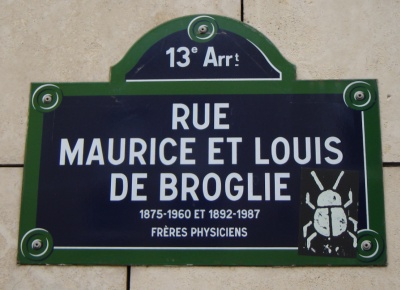
Louis de Broglie won the Nobel prize in physics for his work on the
wave nature of the electron, but for some reason he's listed in the MacTutor
biographies of mathematicians and (more importantly) the list of mathematicians
with Paris streets named after them. So, I decided to give him
the benefit of the doubt. His brother
Maurice
was an experimental physicist who worked on X-ray diffraction and
spectroscopy.
July 11, 2007
Thomas Payne sent me a couple more references on thorium:
Hi John,I'm going to the Abel Symposium in Norway later this summer — at least if I manage to buy airplane tickets. I'd been meaning to see some glaciers before they melt. Now I'll also have to ask people what they think about thorium power!Cool! (Pardon pun.)
Two web sites worth checking:
- Kirk Sorensen, Energy from Thorium. This guy has collected tons of stuff. He is a big proponent of molten salt reactors and makes a good case for them.
- Liz William, Green nuclear power coming to Norway, Cosmos, May 24, 2007. Report on Norway's decision to go forward with Thorium.
Thomas Riepe sent me this link, which argues that nuclear power is unfeasible for political reasons — terrorism, limitations of the International Atomic Energy Agency, and so on:
First, the Islamic art, which helped satisfy my yearning for everything to do with Andalusia. The richness of art, philosophy, science and technology not just in Granada and Cordoba, but in Cairo, Baghdad, Isfahan and many other capitals, all while Europe was suffering through the dark ages, is somehting I find very alluring.
I really like this celestial sphere — acquired in Cairo in the 1800s, it's an Indian copy of one made in Iran around 1285. Click on the image for a more detailed version, where you can see the Arabic script:
Then, Italian Renaissance painting.
It's amazing to walk through galleries, stumble on a strikingly expressive portrait, and discover that it's a da Vinci.
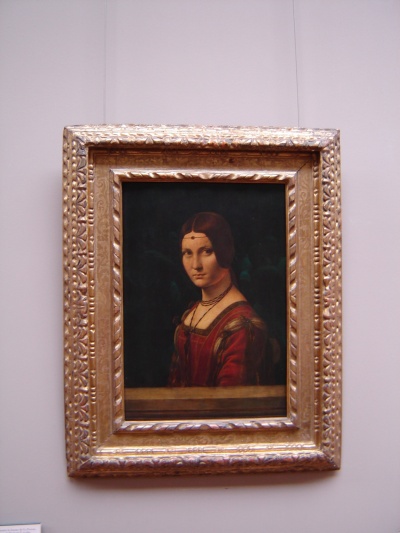
This is a painting of Lucrezia Crivelli, the second mistress of Ludovico Sforza, duke of Milan in the latter half of the 1400s. The painting is called La Belle Ferrionère, after the chain on her forehead, called a ferronière. I'd seen a somewhat similar portrait by Da Vinci in the National Gallery in Washington D.C. — sometimes also called La Belle Ferronière, but more commonly the Lady with an Ermine.
I thought I'd be too jaded by images of the Mona Lisa to get excited by the real thing... but to my surprise, I was tremendously moved by the vast crowds gathered to see it, like pilgrims paying reverence to a holy icon. The cameras flashing, the video recorders, the cell phones held aloft to capture a glimpse, almost overwhelmed the tiny painting itself.
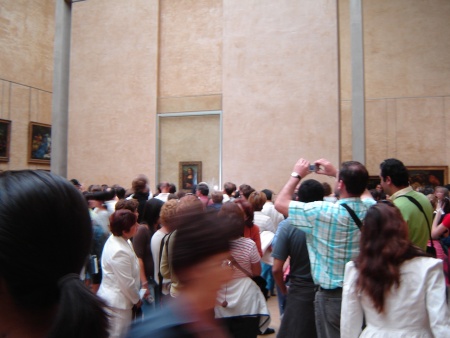

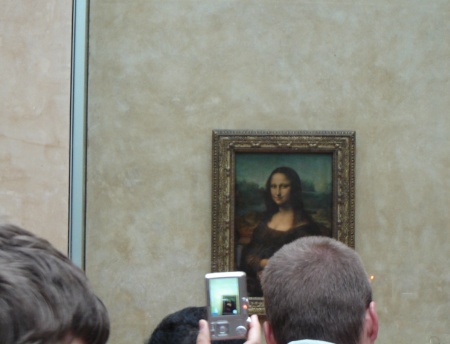
This feeling — of an almost pathetic fragment of the past being cherished and nearly overwhelmed by adulation — of the tragic erosion of history under the ravages of time — struck me even more strongly as I ascended the steps towards the Winged Victory of Samothrace.
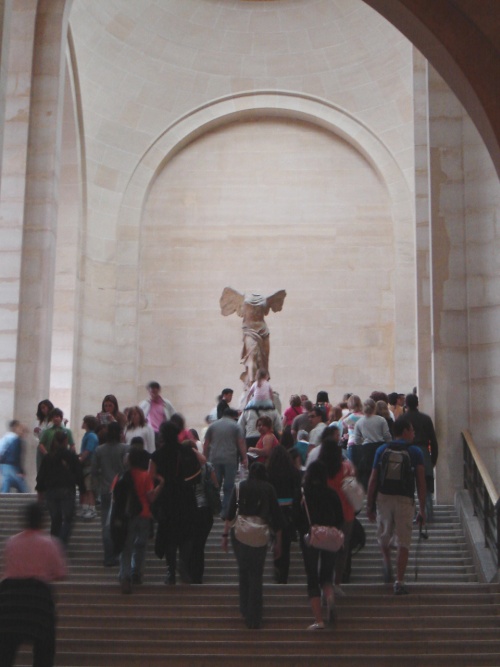
From the Wikipedia article:
The Victory is one of the great surviving masterpieces of sculpture from the Hellenistic period, despite the fact that the figure is significantly damaged, missing its head and outstretched arms. By an unknown artist, (presumably Rhodian in origin), the sculpture is thought to date from the period 220 to 190 BC.The past is not only passed, physics tells us that much of it is truly erased, and in a very real sense does not exist — any more than the future does. The broken Venus de Milo yet again made me think how many of our best achievements are shattered or ruined — and perhaps loved all the more precisely for that reason.The statue stands on a rostral pedestal of gray marble representing the prow of a ship, and figures the goddess as she descended from the skies to the triumphant fleet. Rendered in white Parian marble, the figure originally formed part of the Sanctuary of the Great Gods. Before losing her arms, Nike's right arm was raised, either to bring a trumpet to her lips as she is depicted on coins or to crown the naval victor. The prow is made of grey marble from Lartos. The statue has been reassembled in stages since its original discovery in 1863. The prow was reconstructed from marble debris at the site by Champoiseau in 1879 and assembled in situ before being shipped to Paris. The discovery in 1948 of the hand raised in salute, which matched a fragment in Vienna, established the modern reconstruction.
The right wing is a symmetric plaster version of the original left one. Various other fragments have since been found: in 1950 one of the statue's hands was found on Samothrace and is now in a glass case in the Louvre next to the podium on which the statue stands. Neither the arms nor the head have been found.

While standing here, I overheard a smartaleck teenager ask his friend: "Why does everyone feel they need to take photos of famous stuff they've already seen?"
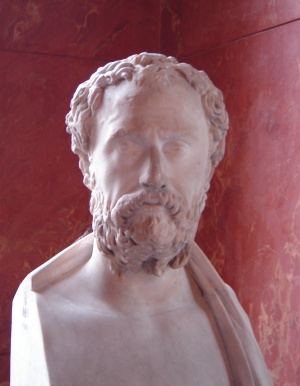
One can react to the mortality of all things philosophically, like Marcus Aurelius here, once emperor of Rome and now a statue among many in the Louvre, who wrote:
Or one can immerse oneself in the moment, like this Roman child... or this Roman duck:
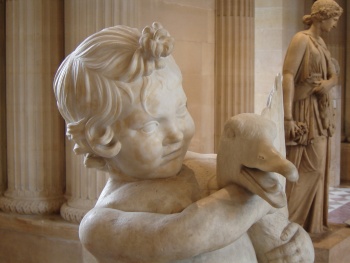
The fellow who decorated the walls would probably say I need to lighten up:
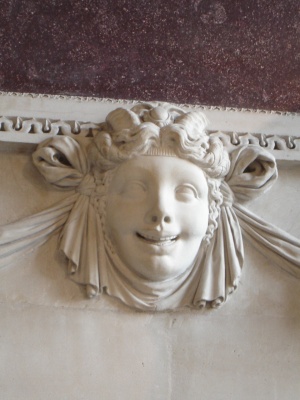
July 15, 2007
In Paris, fire stations hold public dances on the night before
Bastille Day! Unfortunately we missed those. Yesterday,
on Bastille Day itself, we went on a long walk around
Montparnasse.
We missed the military parade, which for the first time featured
troops from throughout the European Union.
After dinner, we caught a nice
glimpse of the
fireworks
near the Eiffel Tower by standing west of the
Pantheon.
But today, we saw the most impressive and cheerful sight of all: people lining up to try riding bikes from the new Parisian communal bike program!

A New French Revolution's Creed: Let Them Ride Bikes
Katrinn Benhold, New York TimesPARIS, July 15 — About a dozen sweaty people pedaled bicycles up the Champs-Élysées on Sunday toward the Arc de Triomphe, as onlookers cheered.
These were not the leading riders of the Tour de France racing toward the finish line, but American tourists testing this city's new communal bike program.
"I'm never taking the subway again," said a beaming Justin Hill, 47, a real estate broker from Santa Barbara, Calif.
More than 10,600 of the hefty gray bicycles became available for modest rental prices on Sunday at 750 self-service docking stations that provide access in eight languages. The number is to grow to 20,600 by the end of the year.
The program, Vélib (for "vélo," bicycle, and "liberté," freedom), is the latest in a string of European efforts to reduce the number of cars in city centers and give people incentives to choose more eco-friendly modes of transport.
"This is about revolutionizing urban culture," said Pierre Aidenbaum, mayor of Paris's trendy third district, which opened 15 docking stations on Sunday. "For a long time cars were associated with freedom of movement and flexibility. What we want to show people is that in many ways bicycles fulfill this role much more today."
Users can rent a bike online or at any of the stations, using a credit or debit card and leave them at any other station.
A one-day pass costs 1 euro ($1.38), a weekly pass 5 euros ($6.90) and a yearly subscription 29 euros ($40), with no additional charges as long as each bike ride does not exceed 30 minutes. (Beyond that, there is an incremental surcharge, to make sure that as many bikes as possible stay in the rotation.)
I also met Michel Egeileh, a grad student who wrote his thesis on the relation between Cartan geometry, supergravity and Higgs fields. This has interesting relations to Derek Wise's work, and indeed cites it. A taste of what adapting to climate change is like: in this case, drought on the Cape Verde islands:
I forgot my camera, so all the pictures that follow were taken by Lisa.
We met the astrophysicist Cécile Barbachoux at the entrance of what seemed like a typical dull modern office. She then led us through it into a wonderful world full of gardens and old buildings.
The first thing we saw were these stables:
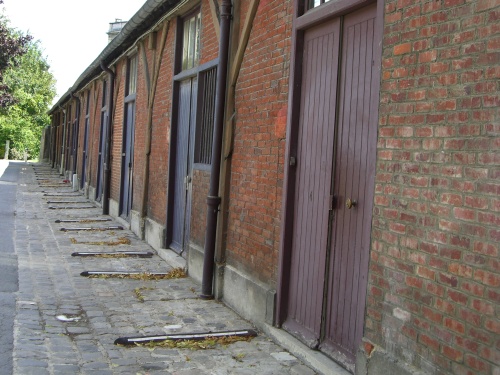
They're now used as rooms for constructing astronomical equipment, but the observatory was constructed at the behest of Louis the Fourteenth, starting around 1667, when horses were very much the thing.
We then walked past some gardens and came to the house where the director of the observatory lives:
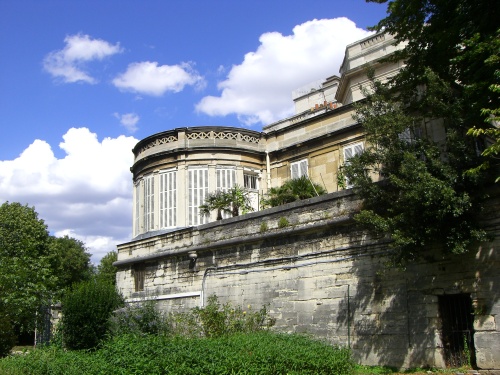
Note the spooky dark doorway below — there are many secret passages, stairways, and underground laboratories here!
The first director of the observatory was Giovanni Domenico Cassini, who apparently lived in this location before the observatory was even built. He's famous for discovering the first 4 moons of Saturn, the Cassini division in Saturn's rings, the Great Red Spot of Jupiter, and so on.
Rounding the bend we came to the grand entrance and saw a big statue of Urbain Le Verrier, who was director from 1873 to 1877. Le Verrier specialized in celestial mechanics, and used perturbations in the orbit of Uranus to predict the location of Neptune.
Even more interesting to me was this plaque:

Here is where Ole Rømer measured the speed of light in 1676! — with the help of Christiaan Huygens, and the shadow of Jupiter's moon Io. As someone fascinated by relativity, the first measurement of something so important as "la vitesse de propagation de la lumière" has always seemed very exciting to me.
Inside the observatory, Cécile used her specially procured ring of keys to open various secret doors and show us wonders starting with Foucault's telescope, which is made of wood:
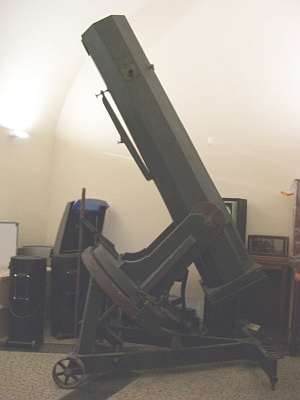
Léon Foucault is more famous for his pendulum, which he used to demonstrate the rotation of the Earth. In fact, every scientist in Paris received an invitation to L'Observatoire de Paris to see this pendulum on February 3rd, 1851. Napoleon III later created a post of Physicist Attached to the Imperial Observatory specially for Foucault, during the time Le Verrier was director, and this is when Foucault began making telescopes.
We then ascended many flights of stairs until we reached the roof:
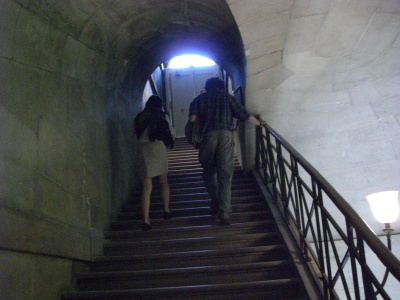
where we saw a marvelous view of Paris.
We scrambled over the roof and entered the observatory proper:
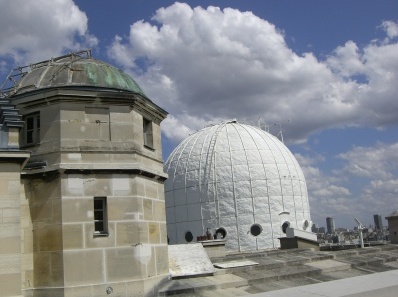
Inside, it was very dark, and dominated by a huge telescope:
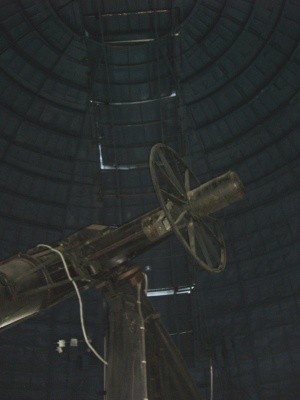
Apparently this old telescope is still used in some demonstrations, just for fun — but nowadays, even a small modern telescope can do better.
We then descended a small spiral staircase, getting a nice view of the steel reinforcements that support the heavy telescope, and eventually worked our way to the library. Here we saw many more nice old telescopes:
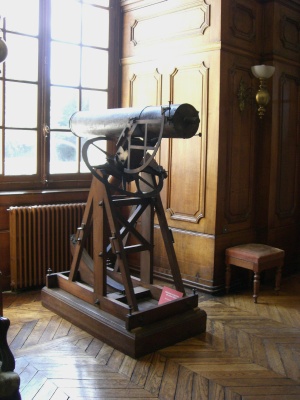
We also saw sextants, globes, celestial spheres, heliostats, and other curiosities — for example, a marble statue of Cassini, as well as this one of Laplace:
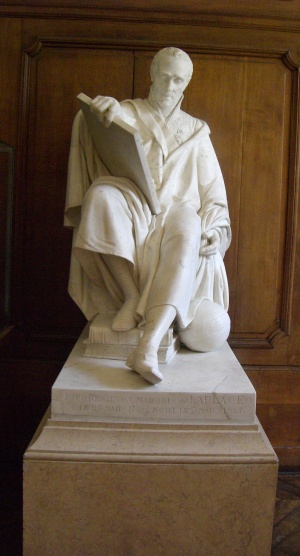
The celestial sphere at his feet is a nice classical allusion: it reminds me of a statue of Athena in the Louvre, where she is for some reason holding such a sphere, more typically the property of Urania.
Pierre-Simon Laplace is now most famous for his work on probability theory, celestial mechanics and the like, but he also directed L'Observatoire de Paris. The astronomer Delambre later wrote:
... never should one put a geometer at the head of an observatory; he will neglect all the observations except those needed for his formulas.This could equally well have been said about Hamilton, who also lived in an observatory, and made his wife do most of the observations!
To reach her office, she needs to climb yet another twisty little spiral staircase — the place is full of them. I find it very romantic, but I wonder how many aging astronomers have plunged to their deaths here.
She showed us this astrolabe:
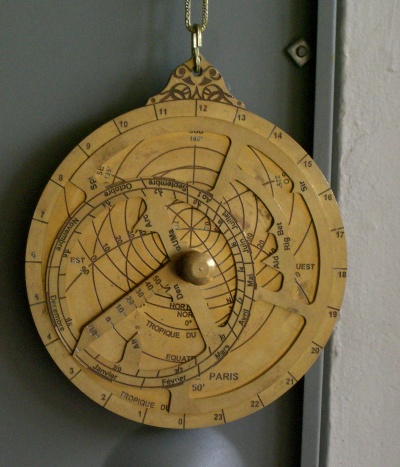
This was made by a 16-year-old student as part of the observatory's educational program!
On our way out, we caught a nice view of some smaller observatories:
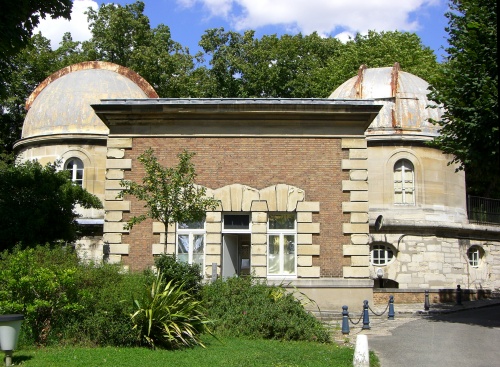
We then met Joseph Kouneiher and went to a café near
Montparnasse.
Much to my surprise, Joseph told us that Leibniz had invented
a calculating device, the stepped reckoner, in 1674. Two prototypes were
built. One was lost in an
attic of the University of Göttingen until a worker found
it in 1879 — while fixing a leak in the roof! It's now
in the State Museum of Hanover.
July 19, 2007
We left Paris today. We were sad to leave
so soon! I was just getting to know the place.
Luckily, there's a good chance we'll visit again next summer.
We flew to Athens; David Corfield flagged us down as we passed through customs, and we took the 2-hour ride to Delphi in a van with some other arrivals. Delphi is perched on the slopes of Mount Parnassus, with a view of the Bay of Corinth. It's a dramatic place:

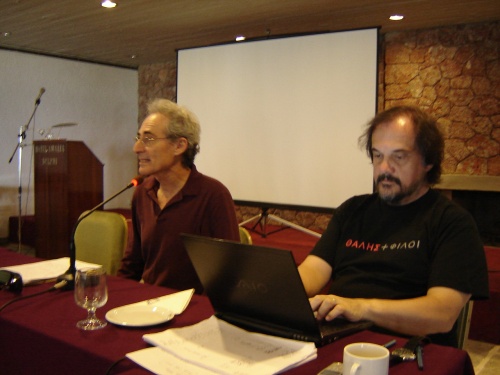
Barry Mazur and Apostolos Doxiadis
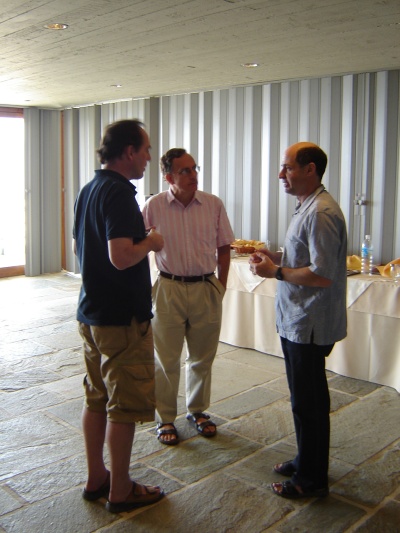
David Corfield, Colin McLarty and Michael Harris
I also got acquainted with the algebraic geometer Michael Harris, who happens to work at Paris 7, where I was visiting just before coming to Greece! Unfortunately I was too polite (or shy) to ask Barry Mazur or Michael Harris many questions about étale cohomology, the Langlands program and so on. But, I got a nice second-hand account of the étale fundamental group from McLarty, who had quizzed Mazur about it — part of the research McLarty is doing for a paper on Grothendieck.
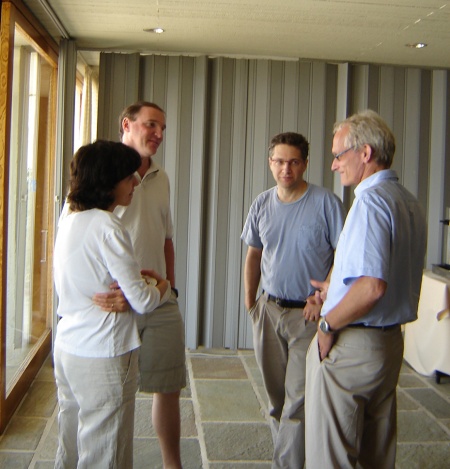
Federica La Nave, Amir Alexander, Peter Galison and Jan Christoph Meister
Everyone at this conference is interviewing someone else. These
interviews will supposedly be transcribed and edited, to appear
with the papers we're presenting. This afternoon
I got interviewed by Federica La Nave, a historian
of mathematics at Hong Kong University, who is currently working on
the role of belief in
Rafael Bombelli's discovery of imaginary numbers: first
he didn't "believe in" these numbers, but later he did.
July 21, 2007
This afternoon I went to the oracle at Delphi. It would take a long time to describe, so
I'll just show you some pictures I took. First, a few artifacts
in the museum:
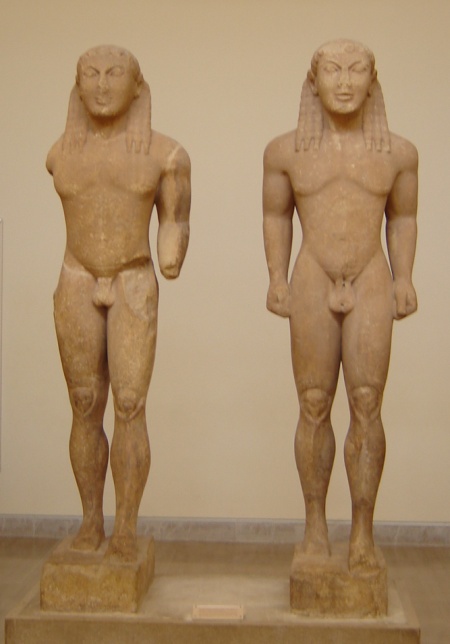
Two kouroi
from around 600 BC.
These guys are big: over 2 meters tall.
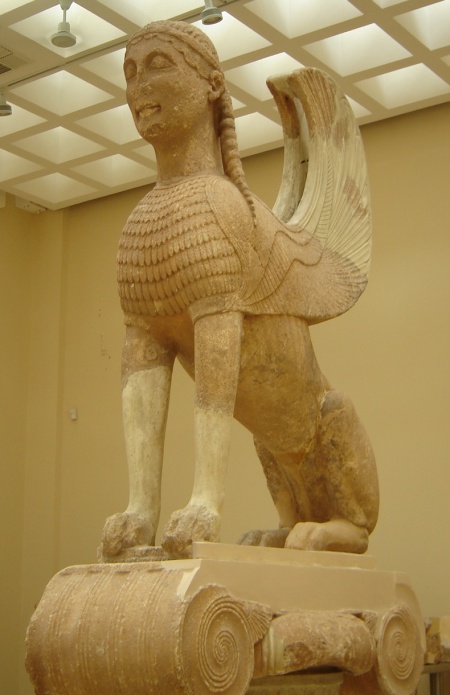
The Naxian sphinx, from around 570 BC.
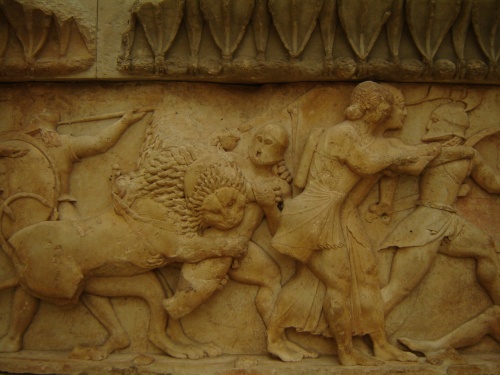
Part of the frieze from the treasury of Siphnos, from
525 BC.
This scene depicts the battle of the gods and the titans.
Many Greek cities donated wealth to Delphi, which was kept
in treasuries.
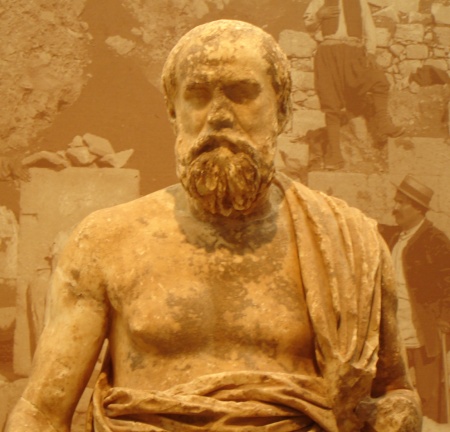
Statue of a philosopher, from around 280 BC.
Then, some pictures from the oracle itself. This is a truly mind-blowing place, both for its rugged natural beauty and the mythology and history behind it. The Oracle of Delphi played an important role in Greek culture for over a millennium: from around 750 BC to around 400 AD. That makes it one of the longest-lived institutions in the world!
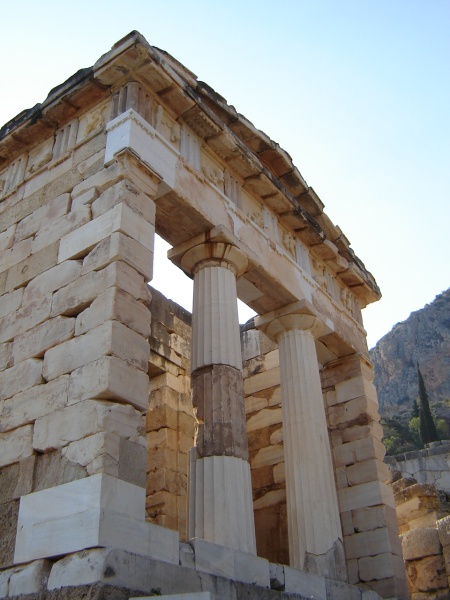
Treasury of
Athens, built around 490 BC to commemorate the Battle of
Marathon.
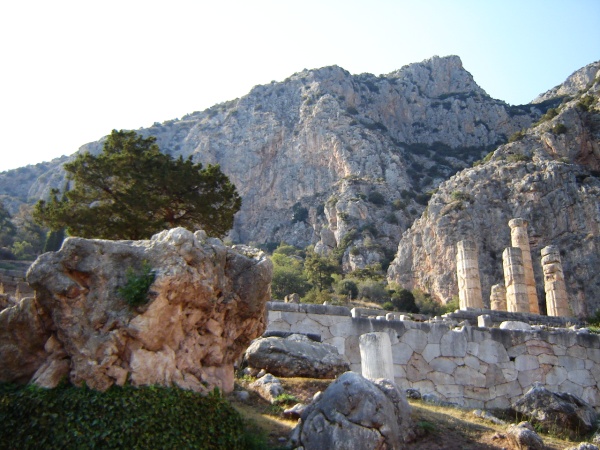
Stone of the Sibyl, at left. Temple of Apollo, at right.
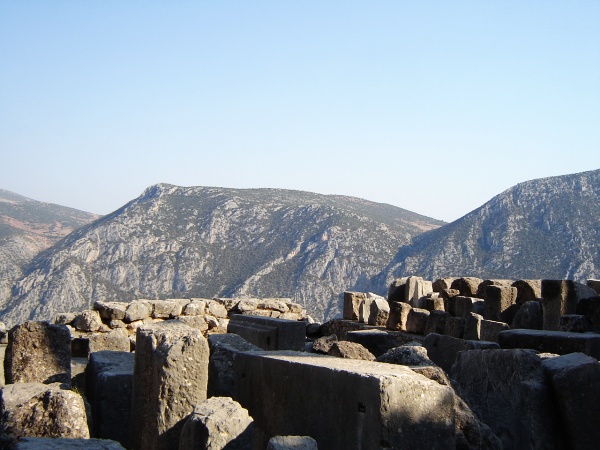
Stones near the Temple of Apollo.
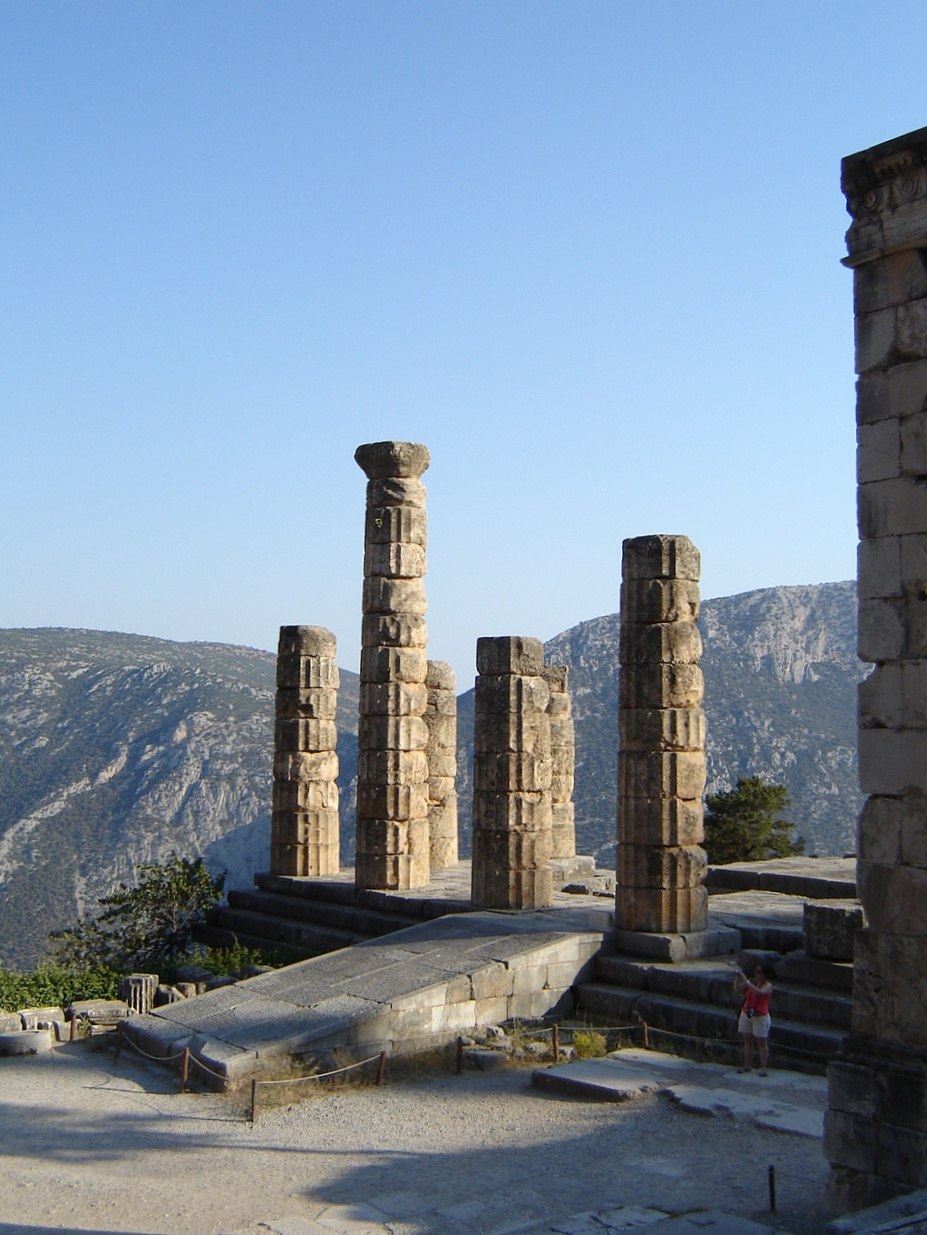
The Temple of Apollo.
This temple is where the Pythia actually did her thing.
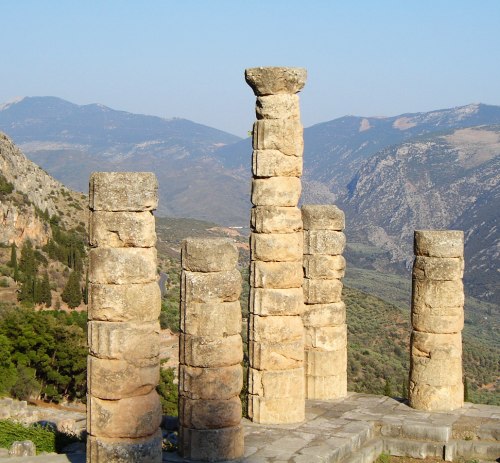
Another view of the
Temple of Apollo.
The temple of Apollo, cradled in the spectacular mountainscape at Delphi, was the most important religious site of the ancient Greek world, for it housed the powerful oracle. Generals sought the oracle's advice on strategy. Colonists asked for guidance before they set sail for Italy, Spain and Africa. Private citizens inquired about health problems and investments. The oracle's advice figures prominently in the myths. When Orestes asked whether he should seek vengeance on his mother for murdering his father, the oracle encouraged him. Oedipus, warned by the oracle that he would murder his father and marry his mother, strove, with famous lack of success, to avoid his fate.The article then goes on to describe how the theory that vapors emitted from the ground was discredited around 1900. But now, thanks to the work of these authors, this theory has been confirmed!The oracle of Delphi functioned in a specific place, the adyton, or "no entry" area of the temple's core, and through a specific person, the Pythia, who was chosen to speak, as a possessed medium, for Apollo, the god of prophecy. Extraordinarily for misogynist Greece, the Pythia was a woman. And unlike most Greek priests and priestesses, the Pythia did not inherit her office through noble family connections. Although the Pythia had to be from Delphi, she could be old or young, rich or poor, well educated or illiterate. She went through a long and intense period of conditioning, supported by a sisterhood of Delphic women who tended the eternal sacred fire in the temple.
The Classical Explanation
Tradition attributed the prophetic inspiration of the powerful oracle to geologic phenomena: a chasm in the earth, a vapor that rose from it, and a spring. Roughly a century ago scholars rejected this explanation when archaeologists digging at the site could find no chasm and detect no gases. The ancient testimony, however, is widespread, and it comes from a variety of sources: historians such as Pliny and Diodorus, philosophers such as Plato, the poets Aeschylus and Cicero, the geographer Strabo, the travel writer Pausanias, and even a priest of Apollo who served at Delphi, the famous essayist and biographer Plutarch.Strabo (64 B.C.-A.D. 25) wrote: "They say that the seat of the oracle is a cavern hollowed deep down in the earth, with a rather narrow mouth, from which rises a pneuma [gas, vapor, breath; hence our words "pneumatic" and "pneumonia"] that produces divine possession. A tripod is set above this cleft, mounting which, the Pythia inhales the vapor and prophesies."
Plutarch (A.D. 46-120) left an extended eyewitness account of the workings of the oracle. He described the relationships among god, woman and gas by likening Apollo to a musician, the woman to his instrument and the pneuma to the plectrum with which he touched her to make her speak. But Plutarch emphasized that the pneuma was only a trigger. It was really the preconditioning and purification (certainly including sexual abstinence, possibly including fasting) of the chosen woman that made her capable of responding to exposure to the pneuma. An ordinary person could detect the smell of the gas without passing into an oracular trance.
Plutarch also recorded a number of physical characteristics about the pneuma. It smelled like sweet perfume. It was emitted "as if from a spring" in the adyton where the Pythia sat, but priests and consultants could on some occasions smell it in the antechamber where they waited for her responses. It could rise either as a free gas or in water. In Plutarch's day the emission had become weak and irregular, the cause, in his opinion, of the weakening influence of the Delphic oracle in world affairs. He suggested that either the vital essence had run out or that heavy rains had diluted it or a great earthquake more than four centuries earlier had partially blocked its vent. Maybe, he continued, the vapor had found a new outlet. Plutarch's theories about the lessening of the emission make it clear that he believed it originated in the rock below the temple.
A traveler in the next generation, Pausanias, echoes Plutarch's mention of the pneuma rising in water. Pausanias wrote that he saw on the slope above the temple a spring called Kassotis, which he had heard plunged underground and then emerged again in the adyton, where its waters made the women prophetic.
Plutarch and other sources indicate that during normal sessions the woman who served as Pythia was in a mild trance. She was able to sit upright on the tripod and might spend a considerable amount of time there (although when the line of consultants was long, a second and even a third Pythia might have to relieve her). She could hear the questions and gave intelligible answers. During the oracular sessions, the Pythia spoke in an altered voice and tended to chant her responses, indulging in wordplay and puns. Afterward, according to Plutarch, she was like a runner after a race or a dancer after an ecstatic dance.
As for me, I'm just playing the tourist and taking advantage of the Hotel
Europa's wireless internet to catch up on my diary, my blog, and
some math papers.
July 25, 2007
It's really hot
here in Greece — 45 Celsius, or 113 Fahrenheit. Global
warming proceeds apace. To add to the misery, there are lots of
fires set by arsonists. In Greece they do this as part of a
trick to acquire land for real estate development, with the connivance
of corrupt local officials.

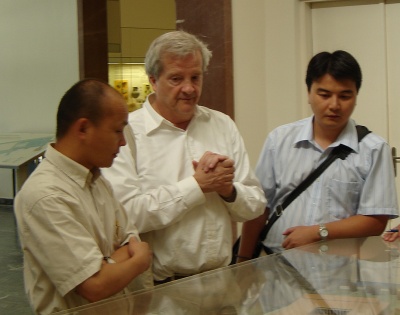
Olympia is a site with many historical layers. Burnt offerings can be found dating back to the 10th century BC. Tradition dates the first Olympic games to 776 BC. It became a place where Greeks from many cities would meet.
I hadn't known that gryphons were an important symbol of royalty in archaic Greece, going back to 700 BC. They're nasty-looking things — a combination of a lion and an eagle, king of the beasts and the birds. There are lots of bronze casts of gryphon heads at Olympia:

The Temple of Zeus at Olympia was built in the middle of the 5th century BC. It contained an enormous ivory and gold statue of Zeus sculpted by Pheidas, which was one of the Seven Wonders of the World.
I have a fondness for Phidias because the Golden Ratio was named φ ("phi") after him. He designed the Parthenon, and some claim he packed it with Golden Ratio rectangles to make it as beautiful as possible. However, the number (√5 + 1)/2 was only named "the Golden Ratio" around 1826, and only named "phi" in 1914. You can read week203 for the full story. It's not clear Phidias really had much to do with phi. But it's still fun stuff. So, I was pleased to see a cup in the museum with an inscription on the bottom claiming that it belongs to Phidias!
Even bigger buildings were constructed during the Hellenistic period, as well as a long race track. The Romans repaired some buildings including the Temple of Zeus when they took over. But, the site was heavily damaged by earthquakes in the 3rd century AD, and by now none of the original temple still stands:
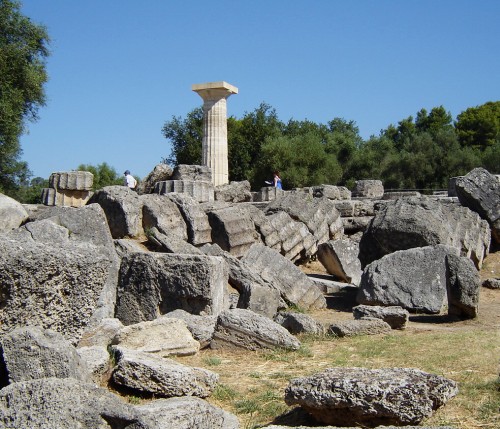
However, the Olympic games were still held
until 393 BC, when the Christian emperor Theodosius I forbid them. So, yet another
institution lasting over a millennium!
July 27, 2007
Lisa's meeting a resounding success, we took a 4-hour bus ride
from Olympia to Athens, arriving around 3 pm. The plan was to
leave for London the next morning, so we spent a night at the
Divani
Palace Acropolis Hotel. This was
a couple blocks south of the Acropolis, not really in the
Plaka area,
but close.
We braved insanely hot weather to climb up to the Acropolis. Here's a brief summary, in the wiseguy style of Wired magazine.
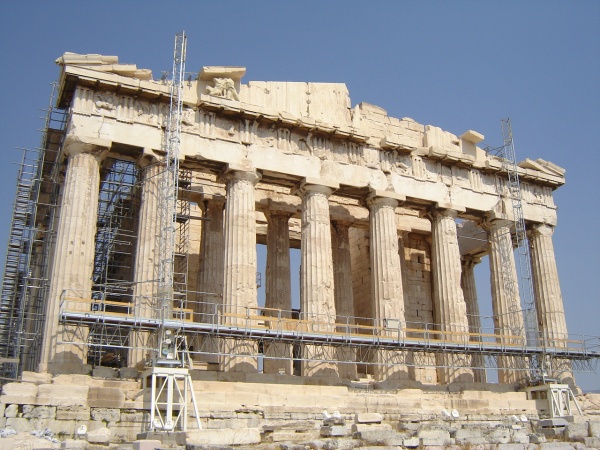
© 2007 John Baez
baez@math.removethis.ucr.andthis.edu